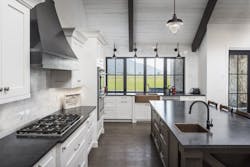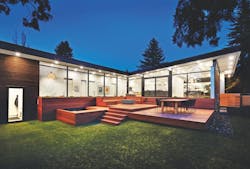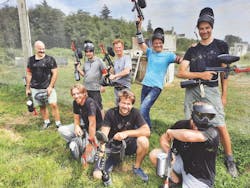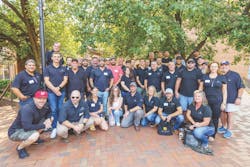Is Custom Remodeling Ready for Alair Homes?
Walter Strong had two goals and two major frustrations in his business: scaling up and transitioning out. Strong, the third-generation owner of Savannah, Ga.-based The Strong Group, had hit a wall that plagues remodelers.
“I had become frustrated with the industry as a whole,” he recalls. “I had watched [companies] try to expand and inevitably, it didn’t end up so well for them. I had watched smaller companies that could never scale outside of the founder, and so their form of exit was either save up enough money to retire or work until you die.”
Strong’s answer came in 2016 in the form of a cold call from Canada-based remodeling franchisor Alair Homes.
That call began the rebranding of The Strong Group, and today Strong owns Alair Homes Savannah and is one of the company’s 20 regional partners. But the biggest change is that his wish for growing his company and finding an exit plan materialized.
Alair Homes began franchising in 2012 and today has 97 locations across Canada and the United States. The company calls itself the largest custom builder and large-scale remodeler in the world, a status achieved through a tailored franchise model where only certain “successful” (averaging a revenue of $5.5 million, according to Alair) and value-aligned remodeling companies are invited to join—a deviation from the traditional franchise model where potential franchisees make the approach.
Large-scale franchising has long eluded the design-build remodeling and home building industry, with a storied history of unsuccessful attempts. Alair aims to change that, but its success over time will shed light on whether a franchise model can work in an industry known for having more variables than constants in its products and approach—common kryptonite for franchise success.
Remodeling Isn’t McDonald’s
The success or failure of a franchiser is determined by four traits, says Joseph J. Fittante, franchise lawyer of more than 20 years at Minneapolis-based Larkin Hoffman: a passion for the brand, favorable economics, continued value offered by the franchisor, and a standard model.
“You know what you’re getting when you go to every McDonald’s or Burger King,” says Fittante. “They look the same, they feel the same, they charge the same, they have the same menu items, et cetera. There is individuality in the remodeling business, which makes that difficult.”
Meanwhile, parallel industry segments such as home improvement, have had an easier time creating that consistency and as a result have done well with growth across multiple markets. The rise of brands such as Dreamstyle, ReBath, and Renewal By Andersen can be partly attributed to a limited menu of specific product offerings (such as tub-to-shower conversions or window replacements) and subsequently, a highly systemized business structure. DreamMaker Bath & Kitchen, the most relatable company to Alair Homes, operates 42 locations across the US, according to its website.
Conversely, individuality may be one issue behind less successful remodeling franchise plays, such as Case Architects & Remodelers.
In 1998, Case developed a franchise model for handyman services, which rapidly grew to about 65 locations nationwide. Initially, the goal was to assist existing remodelers in operating a handyman division in conjunction with their design-build services, but Case later opened the franchise opportunity to entrepreneurs as well.
Within seven years of that launch, those businesses began to fail due to expanding outside the business model, says Mark Richardson, an industry advisor, and president of Case when franchising began.
Jim Kabel, owner of San Jose-based Next Stage Design was one of the final five Case franchisees to depart from the brand in 2020. The franchise was his first foray into residential remodeling, and within a few months of opening the handyman business, a client requested a full kitchen remodel. Despite it not being part of the standard offerings, he agreed to take on the project, as did many other Case franchisees presented with similar opportunities. This scope-creep away from a standard model speaks to one of the four traits needed for success as outlined by Fittante.
Around 2005, Case opened a full-service remodeling franchise, the first of its kind. Yet in addition to “the individuality in the remodeling business” former Case franchisees say that there was also a decline in the value being offered by the franchisor, ultimately impacting the economics—the other three of Fittante’s traits.
“The ones who are struggling say it’s your fault and the ones who are successful say, ‘Why am I paying this?’” says Bruce Case, current Case Architects & Remodelers CEO.
That perceived declined value comes as a larger challenge to the franchising model, suggests Case.
“Given how the support had changed over the years, if the royalties had better matched the value we were getting or the level of support we needed, or didn’t need, as we got larger and more successful, we could have continued,” Kabel says.
More than 15 years later, Alair Homes is trying the model again, and perhaps with better timing as the industry increasingly welcomes technology into each aspect of the remodeling process, allowing smoother communications and collaboration between franchisee and franchisor.
Alair Homes 10 Years Later
CEO Blair McDaniel was 25 when he opened Alair Homes in British Columbia. It was 2007, and McDaniel’s previous experience had been with commercial construction. Alair moved into the US in 2013 and now has 40 offices across Arizona, California, Florida, Georgia, Iowa, North Carolina, Ohio, South Carolina, Texas, Utah, Virginia, Washington, and Wisconsin.
Alair Homes’ franchisees are provided access to its proprietary construction software, back-end marketing, admin services such as accounting, IT, and access to a cultivated network of construction business owners across the country—the latter of which is the most impactful offering, according to several partners. Alair also utilizes the Entrepreneurial Operating System (EOS) to guide partners.
Alair Homes franchisees do not utilize in-house designers, contrary to the approach of many of the largest remodelers in the country. Company officials say this provides cost savings, and cuts out an area of remodeling that is often a profit loss in many successful businesses.
“We want to focus on being the best in the world of project management, and building a team around the client’s project that are best in the world at what they do,” says Director of Market Development Shane Duff, in regards to working with outside designers rather than in house.
The primary roles all Alair franchises have are partner/owner and project managers. Some partners become regional partners who then take on a larger managerial role.
This means some teams must be reduced when transitioning to an Alair franchise. For Walter Strong, that meant losing an office manager and superintendent. Chad and Diane Hatfield, partners at Alair Dallas / Fort Worth | Hatfield, went from 15 employees to eight. This model also protects companies from the industry’s cyclical busts and booms, says Duff.
In addition, the project manager position differs from a traditional PM, explains Duff. The role is one way Alair maintains its standard model, and it’s not unusual for a company to make a new hire when a contractor becomes a franchisee. The PM allows the owner, or partner, to grow the business without working unsustainable hours over time.
At Alair, the PM is an integral part of the franchise and primed to become an owner, if they choose. Their main function is to guide the client from planning to closing out, and of the more than 400 project managers across Alair’s 97 offices, 12 have moved on to own and operate their own franchise.
“You have to first find a project manager who really has the skills that are maybe a little less looked for in our industry,” says Duff. “Normally we’re looking for a construction background and you know how to run a project. Well, that’s great, but that stuff’s easier to teach them than strong organization, communication, and technology skills.”
Are People the Answer?
The franchise business model is Alair’s answer to a fragmented industry, company officials say. And with that solution comes a rich resource for collaboration and insights from peers, without fear of competition. While partners join for various reasons (succession planning, looking to grow, wanting to work fewer hours), this resource benefits all partners, no matter their goal, according to Duff.
President and Chief Development Officer Rob Cecil was initially critical of the model due to this challenge. “The construction industry is highly fragmented and overwhelmingly populated with independent spirits, very proud people—and they should be, they’re hard workers,” says Cecil. “To be able to get a large group of them together rowing in the same direction seemed to me to be a mountain maybe too tall to try to climb."
Yet Alair now says its success comes from its people more so than its systems and processes. It’s the “bottom up” system Alair thrives off of, where partners come together weekly to discuss new ideas, challenges, and solutions. This informs the direction of Alair even more than its leadership team, according to Cecil.
“[Other industry organizations] have done great things, but they have had a difficult time getting builders to put their guard down,” says Jeff Smith, partner at Alair High Country. “Unite like-minded individuals under one brand and you get catapulted.”
Alair partners often gather for regional leadership conferences, and if one partner in Florida runs into a struggle, dozens from North Carolina to Utah can offer up solutions.
“There’s probably a dozen solid reasons why we joined Alair and the absolute number one reason is the people and the reason why it works,” says Diane Hatfield. “We’re part of NARI, we were part of Remodelers Advantage, and that had a lot of peer support, however, we’re not all working on the same process and have the same end goal.”
While Alair approaches contractors with proven success and an established brand, the process before accepting a new franchisee includes a democratic personality analysis. A potential partner must meet with a minimum of five other partners and the entire leadership team before being welcomed in, explains Duff.
To that end, when Bruce Case looks back on the hard lessons learned from his own experience with franchising, one thing is clear.
“Because of all the variables, it becomes very people dependent,” says Case. “And as a result of being so people dependent, in my experience, who you get as owners and their team members becomes really the difference between success and failure.”
In most franchise models, the franchisee will purchase a license as well as pay for ongoing fees and royalties. In exchange they can use the company’s brand and business offerings, such as marketing. Royalties typically range from 4% of revenue up to 12%, according to the US Small Business Administration. Fittante says service-based businesses usually pay 8% to 12% for royalties, advertising contributions, and technology.
Alair can not disclose its fees for legal reasons, but the license cost is as low as the company can offer, according to Duff, and is just enough for Alair to break even. Royalties tier down as revenues increase (something Case also offered), and fees are paid only when specific services are used, such as accounting.
For example, if one partner completes three multi-million dollar projects a year while another completes more smaller projects but with the same total revenue, the partner with the higher volume of jobs requires more accounting services than the other. If the two paid the same percentage, it would not be equal.
The business model aims to maintain a consistent margin, even at growth. Duff shares that Alair benchmarks partners to achieve net margins of 11%, with some obtaining higher margins and others lower.
“We are still living in those days as custom builders and remodelers where we’re all in our respective markets, we’re operating in vacuums, we’re holding a lot of our secrets close to the chest,” says Duff. “But the problem is, even if you do share with others, you’re running totally different companies. Collectively, we’ve said, ‘Why are we all doing the same thing repetitively in our markets? What if we joined forces? What if we sat at the table and we compared what worked and didn’t work for us, and we developed a single model that solved as many of those challenges as possible?’”
Back when Case attempted to franchise full-service remodeling, it was met with observations on consolidation and the remodeling industry’s ripeness to accept that. Those comments are still made today, and Alair’s future will reveal whether it’s due to the readiness of the industry or the approach.
Is Remodeling Franchisable?
Consolidation has been a trend seen across industries, with mergers and acquisitions picking up steam, especially in the replacement contracting side of the business. Both the automotive and real estate industries have undergone intense consolidation in recent years, all with the goal to increase profitability. But can consolidation and franchising ever succeed in remodeling?
“I will say, from lessons learned or gray hair, there’s certain things that are franchisable and certain things that aren’t, and home remodeling, in particular, is not very franchisable,” says Mark Richardson, industry advisor and former president of Case Architects & Remodelers.
For current CEO Bruce Case, focusing on simpler projects with fewer variables, closely monitoring cash flow, and bringing in franchise-specific team members would be areas he’d redo, along with a more in-depth vetting process.
“A third challenge was bringing on the right people. The right franchisees, because you can vet as much as you want. But when somebody gets in the system, do they follow your system, do they listen, do they treat clients right?”







